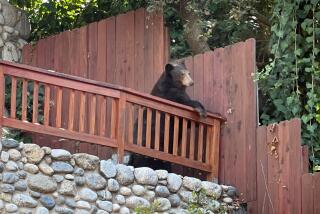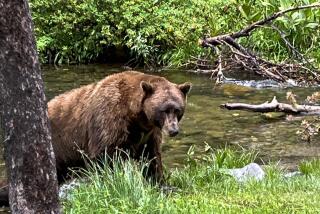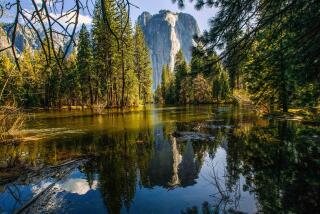Intrepid Duo Tries to Snare Prey That Could Devour Them
- Share via
EASTPORT, Idaho — Rotting road kill, cow blood and fish guts are the tools that Barb McCall and Kerri Lippert carry into the woods near the Canadian border.
Those pungent scents attract bears, and it is the job of the two young women to catch, collar and release as many as 20 bruins this summer.
“I’ve always liked horses and dogs,” Lippert, 22, said while climbing through thick brush to check bear traps. “But I wanted to work with more exciting animals. Ones that could eat you.”
McCall and Lippert, the Idaho Department of Fish and Game’s first all-female bear-trapping team, crisscross Forest Service roads each morning, looking for their quarry.
One midsummer day, they checked seven traps they had built and stocked with hacked-up deer carcasses. The scent of decomposing flesh -- meant to attract bears to the spring-loaded cable snares -- extended in all directions.
Once a bear noses its way into the trap, it steps on a trigger and is snatched by the ankle. The women check each trap every morning.
They approach the traps armed only with an industrial-sized container of pepper spray, which they can use to thwart any surprise encounters.
But when an angry black bear is in a trap, the women tranquilize the animal. Then they measure and weigh each bear, install a radio collar, and yank a tooth to gauge its age.
They slip away before the bear awakens, groggy but unharmed.
They name each bear they catch. One that woke up after being under for only 10 minutes was named “Antsy.”
The middle of summer is a poor time to catch bears, the women say, because the animals roam into high-elevation areas to feast on huckleberries. To try to compete, the trappers have used anise oil, skunks, cow blood and fish guts to lure bears.
The bear-trapping is needed because a new highway is being built through previously forested areas. Idaho Fish and Game wants to know if bears are using three new wildlife underpasses beneath the new road, instead of lumbering into dangerous traffic on the highway.
The pair, working full time, have caught five bears since the project began in early July, but they didn’t expect to hit the jackpot in the middle of summer. Most of this year’s work has gone into selecting appropriate sites and building the traps for use next spring, when bears will be more active at lower elevations.
To build a trap, logs are stacked 3 or 4 feet high in a funnel leading to a tree. A cable is attached to the tree and a 1-foot-wide hole near the entrance hides the trigger for the snare. They cover the hole with dirt and leaves. A series of sticks placed on the ground forces the bear to step in the trap hole. In the back of the trap, which now resembles a cave, the women place their bait and wait for a hungry bear to wander in.
Wayne Wakkinen, a wildlife biologist who oversees the project, said the department’s search for bear-trappers turned up about half men, half women.
“The guys who grew up hunting and fishing just plain old aren’t qualified anymore,” he said. “There’s not a lot of people who know how to trap bears.”
Wakkinen, who said he picked the women because they were the most qualified, said McCall was also certified to handle the tranquilizer drugs. Both have college degrees in wildlife.
The two live in an RV next to a stream on Forest Service land. Although the outdoors lifestyle is enjoyable, McCall said, sometimes all she wants is a shower.
But they can’t imagine doing anything else
“This is the reason I got into wildlife,” McCall said.
More to Read
Sign up for Essential California
The most important California stories and recommendations in your inbox every morning.
You may occasionally receive promotional content from the Los Angeles Times.










